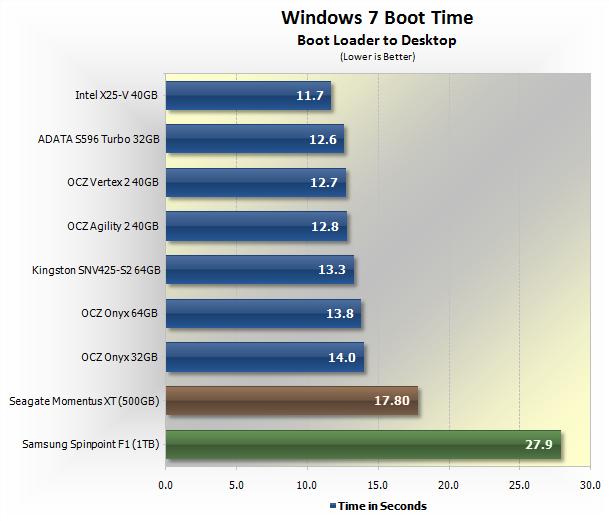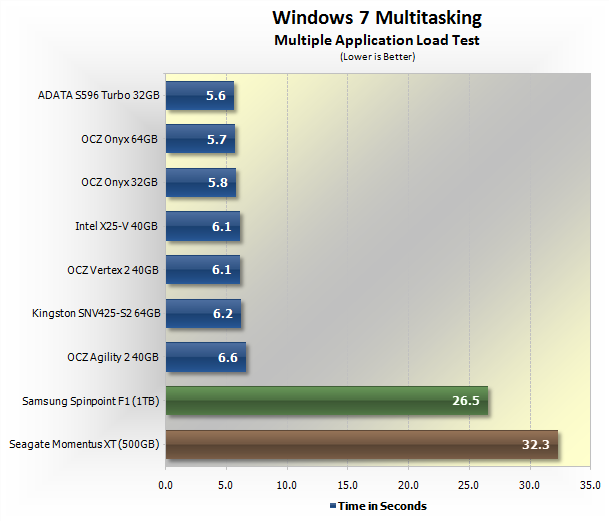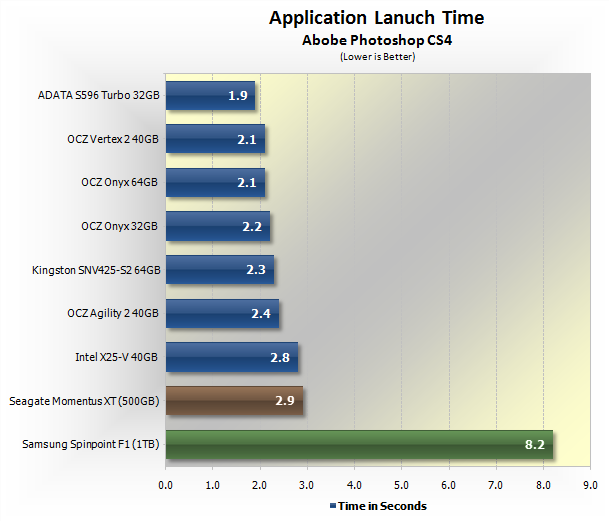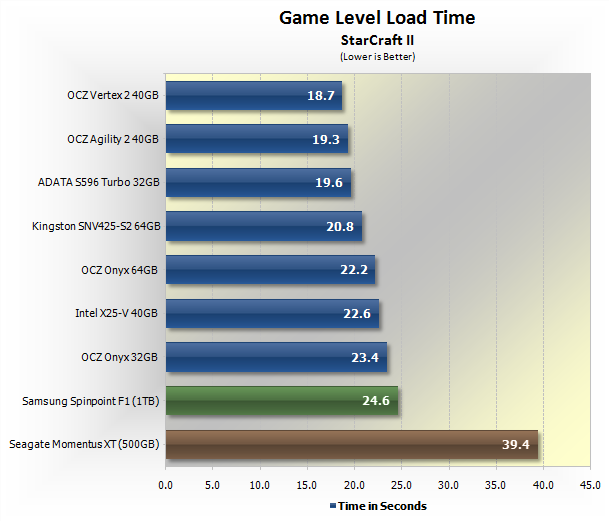Benchmarks: Real-World Applications

The Windows 7 boot time test begins from the moment the initial loading screen appears to the time the Windows desktop is fully loaded. As you can see all SSDs perform exceptionally well here and surprisingly there is very little difference between them.
The Intel X25-V 40GB stands out as the fastest drive taking an average of just 11.7 seconds to load a clean copy of Windows 7. The next fastest drive was the ADATA S596 Turbo 32GB which scored poorly in a couple of our write tests on the previous page.
The OCZ Vertex 2 and Agility 2 40GB drives delivered similar performance to that of the S596 Turbo 32GB while the Kingston SNV425-S2 64GB and OCZ Onyx 32/64GB drives were only slightly slower.
The Momentus XT does bridge the gap between HDD and SSD performance with a load time of 17.8 seconds. Although this is 27% slower than the worst performing SSD that we tested it is an incredible 36% faster than the Samsung Spinpoint F1 1TB hard drive which took 28 seconds to load Windows 7.

For the application load test we load the following applications into the Windows 7 startup: Internet Explorer, Outlook 2007, Access 2007, Excel 2007, PowerPoint 2007, Publisher 2007, Word 2007 and Photoshop CS4. The test starts when the Windows 7 startup sound loads to the time the final application is loaded.
This is where SSD technology really shines and we see this with all drives taking just 5 to 7 seconds to complete the entire task. Interestingly, it was the ADATA S596 Turbo 32GB and Onyx 32/64GB the only drives to crack the 6 second barrier. However with close results on all three runs it is difficult to determine a definitive winner. Let's just say SSD technology wins here.
We were surprised to see that the Momentus XT 500GB was slower than the Samsung Spinpoint F1 1TB hard drive in this test. Taking 32 seconds to load all eight applications at once is pretty slow going, particularly when a standard desktop hard drive did it in 26 seconds.

This test measures the time it takes to load Adobe Photoshop CS4 from the time we click on the icon to the time the program is completely loaded and ready to use. On an average budget SSD this takes roughly 2 seconds. The ADATA S596 Turbo 32GB was again the fastest SSD tested clocking an average time of just 1.9 seconds.
The Intel X25-V 40GB was the slowest taking 2.8 seconds on average. Still none of the seven drives test is going to allow you to make coffee while you wait.
Although the Seagate Momentus XT 500GB struggled with our previous application loading test it appears that this drive is very snappy when loading a single application as it delivered SSD-like performance.

This next batch of results was recorded when loading the last level from the single campaign in StarCraft II. The test began the second the load screen appeared and was stopped once the "click to play" message appeared.
Using a 3.5" desktop hard drive the game takes on average around 24 seconds to load this level. The Seagate Momentus XT 500GB was much slower loading the level in 39 seconds. By comparison the slowest SSD tested was the OCZ Onyx 32GB which took 23 seconds followed by the Intel X25-V 40Gb which took 22 seconds.
The fastest SSD test was the OCZ Vertex 2 40GB which completed the test in 18.7 seconds making it a fraction faster than the Agility 2 40GB and ADATA S596 Turbo 32GB drives.